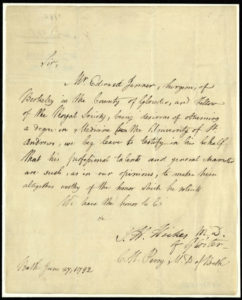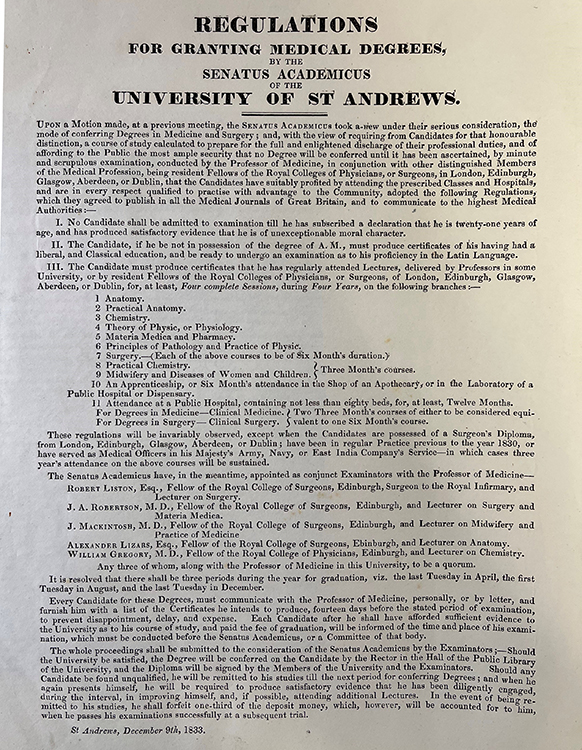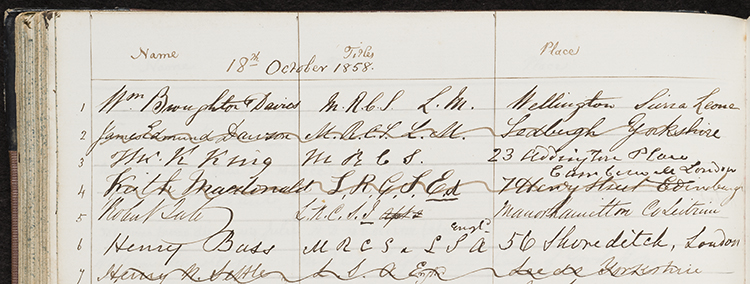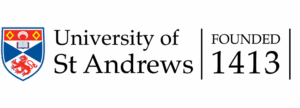Dr Manon C Williams is a historian of medicine and alumni of the University of St Andrews, School of History (2024). Working in collaboration with the School of Medicine, she researched and designed an installation to celebrate past medical alumni in the school’s history. This blog showcases some of the archival resources available at University of St Andrews Libraries and Museums that can be used to explore the early medical alumni of St Andrews.
Before the creation of the combined medicine and surgery bachelor’s degree (MB ChB) in the mid-nineteenth century, a medical doctorate (MD) was the main medical qualification in Britain.
MD by testimony
In the 18th and early 19th centuries, the St Andrews MD was awarded on the basis of testimonials from other physicians. Edward Jenner (1749–1823, MD 1792), creator of the smallpox vaccine, is perhaps the most famous St Andrews alumnus to receive an MD by recommendation. You can read the testimonial on his behalf here in our archives:

Jenner’s most famous contribution to medicine was his invention of the smallpox vaccine, which you can read more about here: https://university-collections.wp.st-andrews.ac.uk/2018/05/14/edward-jenner-and-the-smallpox-vaccine/.
MD by examination
From the 1830s, candidates could also receive an MD by examination, provided they had sufficient proof of medical training and education. This became a popular way for non-European practitioners to gain accreditation in Britain.

In 1856, Rustomjee Byramjee (1833–1913) became the first graduate of St Andrews from a non-European background. Born in India, Byramjee passed his MD examination at St Andrews in 1856. He joined the Indian Medical Service as assistant surgeon in 1857. He was one of only three Indians admitted to the Indian Medical Service during the East India Company’s rule, and the only stationed in Bombay. He served as superintendent of vaccinations in the Northern Circle and became Surgeon-Major in 1873.
Rustomjee Byramjee listed in the minutes of Senatus Academicus (above), reporting the examinations and confirmation of degrees, with his birthplace listed as Bombay (UYUY452/17).

In 1858, William Broughton Davies (1833–1906) became the first west African to qualify as a medical doctor in Britain. Born in Sierra Leone, Davies was recruited by the War Office to study medicine and serve in the colonial armed forces. After taking courses at King’s College London, he passed his MD examination at St Andrews in 1858. He served in the African Medical Service for the remainder of his career and was appointed Surgeon-Major in 1875.
William Broughton Davies listed in the minutes of Senatus Academicus (above), reporting the examinations and confirmation of degrees, with his birthplace listed as Wellington, Sierra Leone (UYUY452/17).

Byramjee and Davies represent the diversity of MD alumni, however, their medical education in Britain was directly correlated to serving under a repressive colonial regime.
A Battle for Inclusion
Women were initially excluded from gaining medical degrees, though not through lack of trying. Elizabeth Garrett (1836–1917) was the first woman to matriculate at St Andrews in 1862. She was blocked from pursuing an MD degree by the Senate. Undeterred, she continued her studies privately and in London and received her medical licence in 1865.
Marion Gilchrist (1864–1952) was the first woman to graduate with a medical degree in Scotland. In 1890, she received a Lady Literate in Arts, the only qualification offered to women at St Andrews, before pursuing an MBCM at Glasgow in 1894.
National reforms allowed women to earn degrees at Scottish universities from 1892.
Agnes Forbes Blackadder (1875–1964) was the first female MA graduate from St Andrews in 1895. She would later receive an MB ChB from Glasgow in 1898 and an MD in 1901.
Group portrait featuring Agnes Forbes Blackadder (fourth from the right) and her family. Agnes was the first female graduate of the University of St Andrews.
The MB ChB degree
In 1897, the Bute Medical School was founded in St Andrews. The following year, it was affiliated with University College Dundee, forming a conjoint medical school. This allowed St Andrews to confer MB ChB degrees. The new offer of the MB ChB degree from 1897 displaced the MD as the primary degree for medical practice.
In 1905, the first three women graduated in medicine at St Andrews, Elizabeth H B MacDonald (1880–1969), Jessie Balsillie (1881–1940), and Alice Jean Donaldson. Read more about these women and the pioneers that came before them here: https://university-collections.wp.st-andrews.ac.uk/2025/03/07/international-womens-day-the-first-women-in-medicine-at-st-andrews-and-dundee/.

If you would like to learn more about the graduates of St Andrews’ MB ChB programme, a new installation has been put up on the ground floor of the School of Medicine, next to the Fairlie Café. This installation showcases some of the most notable alumni from the MB ChB programme over the last century. An online version of the content is also available here: https://medicine.st-andrews.ac.uk/alumniinhistory/.
Dr Manon C Williams
Discover more from University Collections blog
Subscribe to get the latest posts sent to your email.
